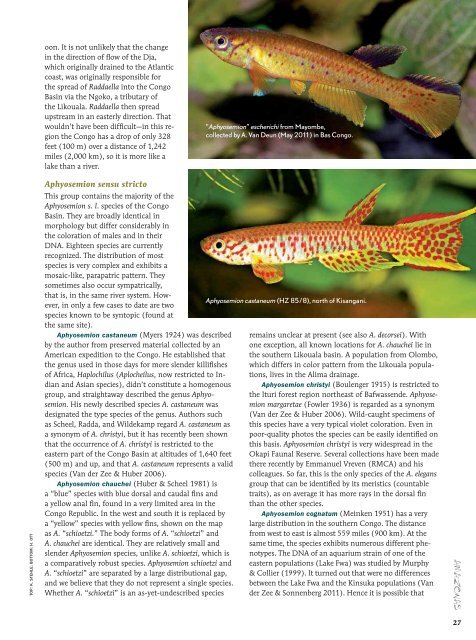Congo Killies - PageSuite
Congo Killies - PageSuite
Congo Killies - PageSuite
You also want an ePaper? Increase the reach of your titles
YUMPU automatically turns print PDFs into web optimized ePapers that Google loves.
oon. It is not unlikely that the change<br />
in the direction of flow of the Dja,<br />
which originally drained to the Atlantic<br />
coast, was originally responsible for<br />
the spread of Raddaella into the <strong>Congo</strong><br />
Basin via the Ngoko, a tributary of<br />
the Likouala. Raddaella then spread<br />
upstream in an easterly direction. That<br />
wouldn’t have been difficult—in this region<br />
the <strong>Congo</strong> has a drop of only 328<br />
feet (100 m) over a distance of 1,242<br />
miles (2,000 km), so it is more like a<br />
lake than a river.<br />
“Aphyosemion” escherichi from Mayombe,<br />
collected by A. Van Deun (May 2011) in Bas <strong>Congo</strong>.<br />
TOP: K. STEHLE; BOTTOM: H. OTT<br />
Aphyosemion sensu stricto<br />
This group contains the majority of the<br />
Aphyosemion s. l. species of the <strong>Congo</strong><br />
Basin. They are broadly identical in<br />
morphology but differ considerably in<br />
the coloration of males and in their<br />
DNA. Eighteen species are currently<br />
recognized. The distribution of most<br />
species is very complex and exhibits a<br />
mosaic-like, parapatric pattern. They<br />
sometimes also occur sympatrically,<br />
that is, in the same river system. However,<br />
in only a few cases to date are two<br />
species known to be syntopic (found at<br />
the same site).<br />
Aphyosemion castaneum (Myers 1924) was described<br />
by the author from preserved material collected by an<br />
American expedition to the <strong>Congo</strong>. He established that<br />
the genus used in those days for more slender killifishes<br />
of Africa, Haplochilus (Aplocheilus, now restricted to Indian<br />
and Asian species), didn’t constitute a homogenous<br />
group, and straightaway described the genus Aphyosemion.<br />
His newly described species A. castaneum was<br />
designated the type species of the genus. Authors such<br />
as Scheel, Radda, and Wildekamp regard A. castaneum as<br />
a synonym of A. christyi, but it has recently been shown<br />
that the occurrence of A. christyi is restricted to the<br />
eastern part of the <strong>Congo</strong> Basin at altitudes of 1,640 feet<br />
(500 m) and up, and that A. castaneum represents a valid<br />
species (Van der Zee & Huber 2006).<br />
Aphyosemion chauchei (Huber & Scheel 1981) is<br />
a “blue” species with blue dorsal and caudal fins and<br />
a yellow anal fin, found in a very limited area in the<br />
<strong>Congo</strong> Republic. In the west and south it is replaced by<br />
a “yellow” species with yellow fins, shown on the map<br />
as A. “schioetzi.” The body forms of A. “schioetzi” and<br />
A. chauchei are identical. They are relatively small and<br />
slender Aphyosemion species, unlike A. schioetzi, which is<br />
a comparatively robust species. Aphyosemion schioetzi and<br />
A. “schioetzi” are separated by a large distributional gap,<br />
and we believe that they do not represent a single species.<br />
Whether A. “schioetzi” is an as-yet-undescribed species<br />
Aphyosemion castaneum (HZ 85/8), north of Kisangani.<br />
remains unclear at present (see also A. decorsei). With<br />
one exception, all known locations for A. chauchei lie in<br />
the southern Likouala basin. A population from Olombo,<br />
which differs in color pattern from the Likouala populations,<br />
lives in the Alima drainage.<br />
Aphyosemion christyi (Boulenger 1915) is restricted to<br />
the Ituri forest region northeast of Bafwassende. Aphyosemion<br />
margaretae (Fowler 1936) is regarded as a synonym<br />
(Van der Zee & Huber 2006). Wild-caught specimens of<br />
this species have a very typical violet coloration. Even in<br />
poor-quality photos the species can be easily identified on<br />
this basis. Aphyosemion christyi is very widespread in the<br />
Okapi Faunal Reserve. Several collections have been made<br />
there recently by Emmanuel Vreven (RMCA) and his<br />
colleagues. So far, this is the only species of the A. elegans<br />
group that can be identified by its meristics (countable<br />
traits), as on average it has more rays in the dorsal fin<br />
than the other species.<br />
Aphyosemion cognatum (Meinken 1951) has a very<br />
large distribution in the southern <strong>Congo</strong>. The distance<br />
from west to east is almost 559 miles (900 km). At the<br />
same time, the species exhibits numerous different phenotypes.<br />
The DNA of an aquarium strain of one of the<br />
eastern populations (Lake Fwa) was studied by Murphy<br />
& Collier (1999). It turned out that were no differences<br />
between the Lake Fwa and the Kinsuka populations (Van<br />
der Zee & Sonnenberg 2011). Hence it is possible that<br />
AMAZONAS<br />
27

















